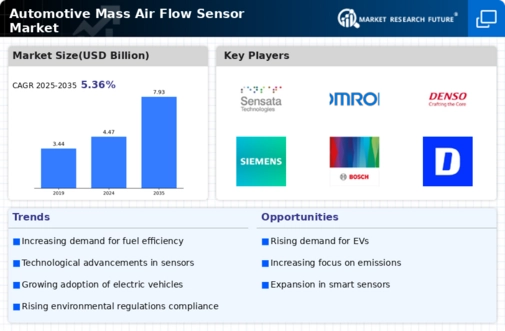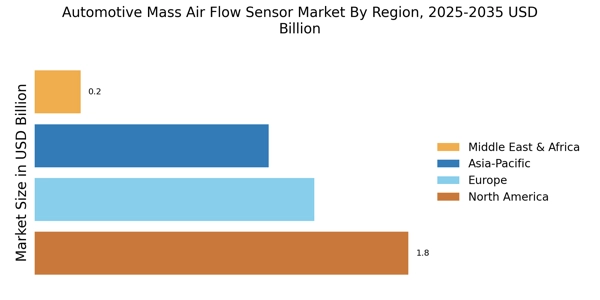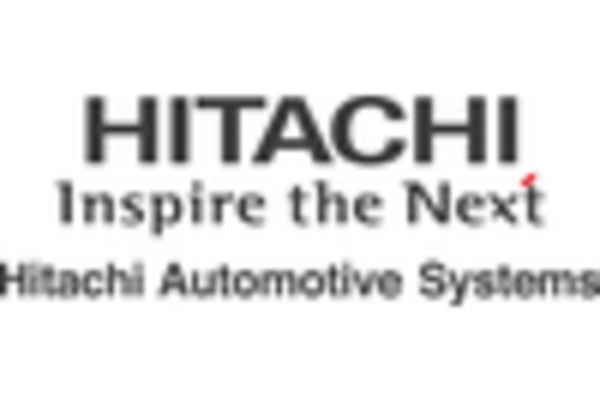Increasing Vehicle Production
The automotive industry is witnessing a surge in vehicle production, driven by rising consumer demand and economic recovery. This trend is likely to bolster the Automotive Mass Air Flow Sensor Market, as these sensors are integral to modern engine management systems. In 2025, the production of passenger cars is projected to reach approximately 80 million units, which could lead to a corresponding increase in the demand for mass air flow sensors. As manufacturers strive to enhance fuel efficiency and reduce emissions, the integration of advanced mass air flow sensors becomes essential. Consequently, the growth in vehicle production is expected to significantly impact the Automotive Mass Air Flow Sensor Market, creating opportunities for manufacturers and suppliers alike.
Rising Environmental Concerns
Growing awareness regarding environmental issues is prompting consumers and manufacturers to prioritize fuel efficiency and emissions reduction. This shift is likely to drive the Automotive Mass Air Flow Sensor Market, as these sensors play a crucial role in optimizing air-fuel mixtures for better combustion. With stricter emissions regulations being enforced in various regions, the demand for efficient mass air flow sensors is expected to rise. In 2025, the market for automotive sensors is anticipated to reach USD 30 billion, with mass air flow sensors contributing significantly to this growth. As a result, the increasing focus on sustainability and environmental protection is poised to enhance the Automotive Mass Air Flow Sensor Market.
Expansion of Electric Vehicle Market
The expansion of the electric vehicle market is influencing the Automotive Mass Air Flow Sensor Market, albeit in a nuanced manner. While electric vehicles do not rely on traditional internal combustion engines, the need for air management systems in hybrid vehicles remains significant. As hybrid technology continues to evolve, the demand for mass air flow sensors in these applications is expected to persist. In 2025, the electric vehicle market is projected to account for 25% of total vehicle sales, which may indirectly support the Automotive Mass Air Flow Sensor Market by fostering innovation and adaptation in sensor technologies. This transition could lead to new opportunities for manufacturers to develop sensors tailored for hybrid applications.
Growing Aftermarket for Automotive Parts
The aftermarket for automotive parts is expanding, driven by an increasing number of vehicles on the road and a growing trend towards vehicle maintenance and upgrades. This trend is likely to benefit the Automotive Mass Air Flow Sensor Market, as vehicle owners seek to replace or upgrade their mass air flow sensors to improve performance and efficiency. In 2025, the automotive aftermarket is expected to reach USD 400 billion, with a substantial portion attributed to sensor replacements. As consumers become more aware of the importance of maintaining optimal engine performance, the demand for high-quality mass air flow sensors in the aftermarket is anticipated to rise, further propelling the Automotive Mass Air Flow Sensor Market.
Technological Innovations in Sensor Design
The Automotive Mass Air Flow Sensor Market is experiencing a wave of technological innovations that enhance sensor performance and reliability. Advances in materials science and microelectronics are leading to the development of more accurate and durable sensors. For instance, the introduction of digital mass air flow sensors is improving data accuracy and response times, which is crucial for modern engine management systems. As vehicles become more sophisticated, the demand for high-performance sensors is likely to increase. In 2025, the market for automotive sensors is projected to grow at a CAGR of 6%, indicating a robust demand for innovative solutions in the Automotive Mass Air Flow Sensor Market.


















Leave a Comment